Categories: Electrician at home, Sockets and switches
Number of views: 15412
Comments on the article: 2
Varieties of sockets: their differences from each other and purpose
Every day we use sockets to connect electrical appliances to a 220 volt network, while we don’t think about the outlet itself. Meanwhile, sockets are different. And in the framework of this article, we will consider how the outlet is arranged, and talk about what kind of outlets generally exist.
In everyday life today, sockets of the European standard are installed everywhere, having a tight fit of the plug, often a recessed seat. The plug holes are, of course, round, the difference between the Euro-standard socket and the old Soviet ones - the socket accepts plugs with thicker pins.
Outlet Elements

Any modern outlet consists of: a base with fasteners, current-carrying parts and a front lining. The base of the outlet with mounting tabs or ears has current-carrying parts on it, and the front plate (panel) is also attached to it. Base material - plastic or ceramic.
Ceramic substrates better tolerate high temperatures, such outlets are more expensive. Outlets with plastic bases are cheaper, but like ceramic ones, they do not support combustion, since plastic is special here - polycarbonate with additives.
As for current-carrying parts, they are made, as a rule, of brass or bronze. Brass is bad only in that un tinned form is easily oxidized under conditions of high humidity, especially when in contact with aluminum, because of which the contacts not only lose their former conductive properties, but also lose their springiness. Therefore, brass contacts are equipped with additional spring washers.
It is better if the contacts are tinned, they differ in a dull white color. Tinned contacts fit more tightly onto the plug pins. But best of all - the contacts are bronze, they are resistant to oxidation and perfectly spring, hold the plug well in place.
Grounding contacts
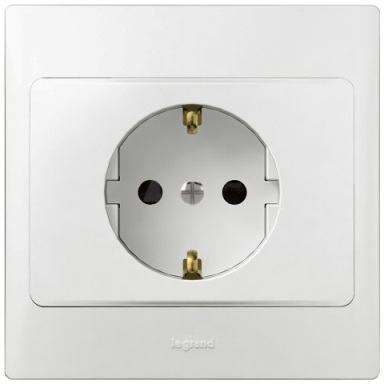
The grounding contacts on the outlet are very important. There are many devices that need grounding both for protection and for the correct operation of electronics. Powerful household appliances, including heatersespecially related to water, such as water heaters and washing machinesare grounded necessarily.
Electronics with microcircuits are sensitive to electrostatics, so computers, televisions, various office equipment and multimedia equipment are also grounded to remove static, in order to avoid failure. For this, sockets with grounding contacts are needed.
Sockets without grounding contact also exist, they are cheaper, usually have a lower landing depth of the plug.
Connection terminals

To connect the wires to the outlet, use the terminals. The terminals can be screw or self-adjusting screwless. The fact is that the screw fastening of the wire is gradually weakening due to the fluidity of the metal of the wire, due to heating of the connection under load. Therefore, it is necessary to tighten the screws in the socket periodically.
Self-clamping connectors automatically tighten the wire, all the time holding it tightly in place of contact. With self-clamping connectors, you will not have to tighten anything during the entire life of the outlet.
Front panel
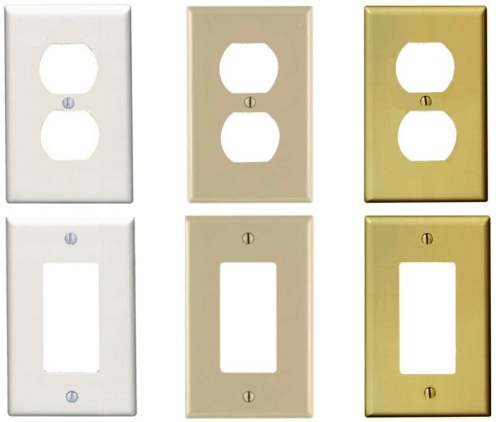
As for the front panel of the outlet, it is most often made of polycarbonate with additives that do not support combustion, but there are sockets with metal, wood, and even glass panels.
The market today offers many designs of outlets with a variety of decorative elements, some of which can be changed to your taste without removing the outlet.
Built-in and patch sockets
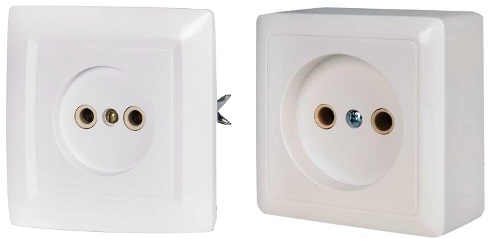
Sockets are built-in and overhead, for hidden and for open wiring.If the wiring passes inside the wall, then it is more advisable to install the socket in the recess in the wall, in the socket, it is safe, this installation is most often used in residential premises.
Overhead sockets are installed when the wiring is open, that is, it goes directly along the wall from above. Such solutions can be found in suburban wooden houses, in garden houses, as well as in non-residential premises, for example, in storage rooms - the outlet is simply fixed to the wall from the outside, and not recessed into the seat, like a built-in one.
For street installation and for internal installation

A conventional outlet for installation in a room does not have any additional elements on the front panel, with the front panel everything ends. But there is street mounting sockets. Here, the front panel has additional protection with a special cover that protects the outlet from foreign objects, rain, dirt, etc., while it is not in use.
For example, a socket for turning on a high pressure washer in the garden may be just that - with a lid. The degree of protection of the shell of such a socket is about IP54.
Curtains in the holes
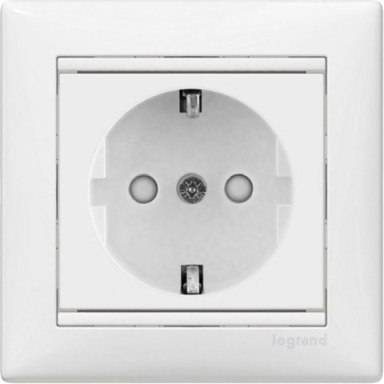
To reliably protect the user from electric shock, there are sockets equipped with protective curtains. The holes in which the plug pins are stuck have special shutters that open the socket contacts only when the contact pin plugs are inserted into the socket.
The mechanism for opening the curtains can be different, they usually open upward when pressed with a fork with effort. These curtains are protection against accidental exposure to foreign objects, so that children are not tempted to stick something into the hole.
Outlets for wet rooms
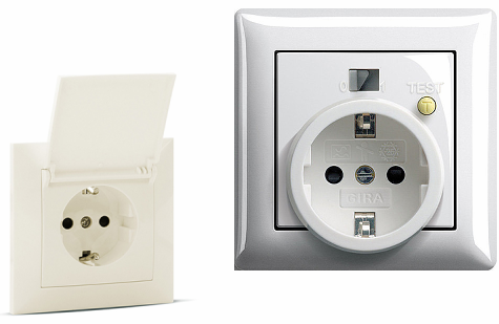
Outlets for damp rooms have an enclosure protection rating greater than normal IP22, such as IP44 or IP54, like the ones with covers for outdoor installation. Data on the degree of resistance of the outlet to moisture and dust are indicated on the package.
Some outlets have built-in leakage protection, i.e. equipped with built-in RCD, outside on such outlets there is a button for testing the built-in RCD.
Socket with switch
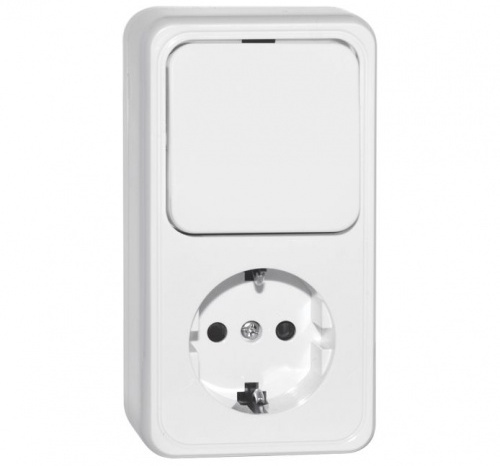
What if it is more convenient to press the button on the outlet and turn on the device plugged into the outlet than to press the button on the device itself? And if there is no button on the device? A socket combined with a switch will be useful here. By pressing the switch, the contact sockets of the outlet are switched to the wiring, and by pressing, they are disconnected.
Plug-Out Socket
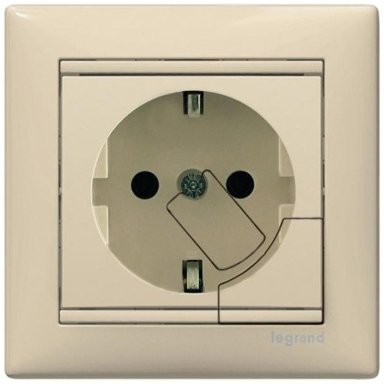
A special button on the outlet allows you to freely pull the plug, with minimal effort. This is useful if you often plug different devices into the same outlet. The stuck plug is held tightly in the socket, but it is worth pushing the button on the side, and the plug can be pulled out very easily, with almost no effort.
Socket with integrated timer
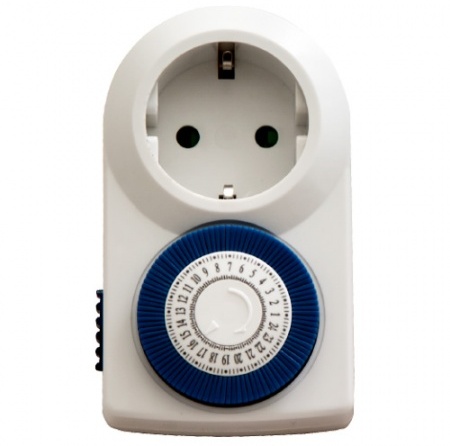
Sometimes it becomes necessary to start a timer so that the device switches off accurately after a while. For example, in order not to forget to turn off the stove or iron. Simply a timer starts at the outlet, and after the set time, the switch will de-energize the load connected to this outlet by 100 percent.
See also on this topic:Sockets and switches in the interior (more than 50 photos)
See also at i.electricianexp.com
:
